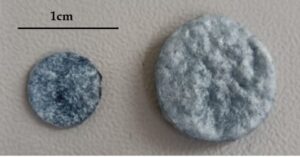Formation of PLGA–PEDOT:PSS Conductive Scaffolds by Supercritical Foaming 18 marzo 2023

Antonio Montes, Diego Valor, Yaiza Penabad, Manuel Domínguez, Clara Pereyra and Enrique J. Martínez de la Ossa
The usage of conjugated materials for the fabrication of foams intended to be used as therapeutic scaffolds is gaining relevance these days, as they hold certain properties that are not exhibited by other polymer types that have been regularly used until the present. Hence, this work aims to design a specific supercritical CO2 foaming process that would allow the production of porous polymeric devices with improved conductive properties, which would better simulate matrix extracellular conditions when used as therapeutic scaffolds (PLGA–PEDOT:PSS) systems. The effects of pressure, temperature, and contact time on the expansion factor, porosity, mechanical properties, and conductivity of the foam have been evaluated. The foams have been characterized by scanning electron and atomic force microscopies, liquid displacement, PBS degradation test, compression, and resistance to conductivity techniques. Values close to 40% porosity were obtained, with a uniform distribution of polymers on the surface and in the interior, expansion factors of up to 10 orders, and a wide range of conductivity values (2.2 × 10−7 to 1.0 × 10−5 S/cm) and mechanical properties (0.8 to 13.6 MPa Young’s modulus in compression test). The conductive and porous scaffolds that have been produced by supercritical CO2 in this study show an interesting potential for tissue engineering and for neural or cardiac tissue regeneration purposes due to the fact that electrical conductivity is a crucial factor for proper cell function and tissue development.
Open Access
https://doi.org/10.3390/ma16062441

